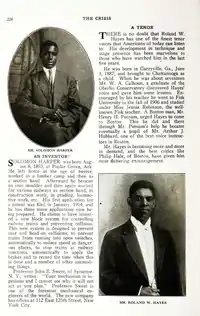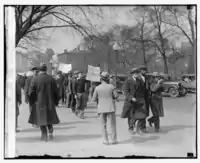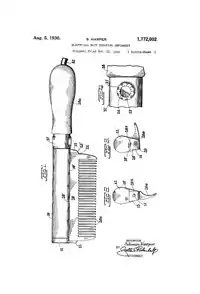Solomon Harper
Solomon Harper (born in Poplar Grove, Arkansas, on August 8, 1893[3]) was an inventor[4] known for creating the first electrically heated hair roller[5][6][2][7] and 28 other inventions. During the course of his career, he struggled to receive recognition and compensation for his inventions.[8] Harper was trained as an electrical engineer[9] and was a veteran. He was a politically active communist, and organized at least one march to picket the White House about unemployment in 1930.[10]

Solomon Harper (upper left) as photographed in The Crisis magazine in 1915

Solomon Harper (2nd from the right) as photographed by the National Photo Company near the White House March 6, 1930.[1]

"Electrical hair-treating implement" patent filed by Solomon Harper in 1924[2]
References
- Spark, Washington Area (March 6, 1930), Blacks, Whites Protest Job Losses: 1930 No. 2, retrieved July 19, 2021
- US 1772002, Harper, Solomon, "Electrical hair-treating implement", issued 1927-12-23
- "Viewing page 9 of 27 | Smithsonian Digital Volunteers". transcription.si.edu. Retrieved July 19, 2021.
- Center, Smithsonian Lemelson (July 23, 2014). "Solomon Harper Papers, 1957-1979". Lemelson Center for the Study of Invention and Innovation. Retrieved July 19, 2021.
- Corporation, Conair. "Hot and Steamy: Our Forever Love Affair with Hair Rollers |". Conair® Corporation. Retrieved July 19, 2021.
- Edmonds, Lauren. "Models walked in a historic fashion show dressed as items by Black inventors, from a hairbrush to a traffic light". Insider. Retrieved July 19, 2021.
- US 2648757, Harper, Solomon, "Thermostatic controlled hair curlers, combs, and irons", issued 1951-10-24, assigned to Harold Watkiss (10%)
- "archives.nypl.org -- Search results". archives.nypl.org. Retrieved July 19, 2021.
- "HARPER, Solomon". Howard University. October 1, 2015.
- "RAGES: Mischief Out of Misery". Time. April 1, 1935. ISSN 0040-781X. Retrieved July 19, 2021.
This article is issued from Wikipedia. The text is licensed under Creative Commons - Attribution - Sharealike. Additional terms may apply for the media files.